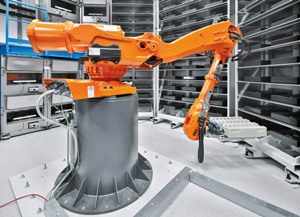Sep 26 2014
Currently, batteries account for around 30% of added value in all electric vehicles. Such a high figure demands the development of solutions for the mass production of car batteries. This is exactly what the Centre for Solar Energy and Hydrogen Research Baden-Württemberg (ZSW) has been doing.
"At our research centre we are working on systems that will allow the German automotive industry to lead the way when it comes to batteries used for electromobility," explains Prof. Dr. Werner Tillmetz, Member of the Management Board of the ZSW. Electric automation technology from Festo is also on board.
 Formation system from Thyssen-Krupp System Engineering: this is where the batteries are brought to life. (Photo: ZSW/Duckek)
Formation system from Thyssen-Krupp System Engineering: this is where the batteries are brought to life. (Photo: ZSW/Duckek)
The production of lithium-ion batteries for use in electric vehicles and for the stationary storage of electricity involves two stages: producing the battery cells and combining the individual cells into battery systems. The cell production stage is the most challenging in terms of production engineering, because it is during this stage that efficiency and service life are determined and therefore also the costs of the cells.
Dry room suitability
In order to minimise contaminants and unwanted chemical reactions such as the deposition of foreign metals or contact with humidity, production must take place in a dry room. Contamination with copper, nickel and tin can result in damage to the battery cell during the charging or discharging process. Up to now, cell production has mostly relied on expensive designs and solutions originally developed for use in clean rooms.
Automation technology that is not designed for dry room conditions may show ageing phenomena, or components or entire machines may suffer premature failure. Festo and Thyssen-Krupp System Engineering have undertaken a series of tests in the battery technical centre to gain new insights into the use of components and production systems in environments with extremely low humidity. The resulting standardised, high-quality and, at the same time, more cost-effective automation solutions can offer a reliable alternative to the more expensive clean room components.
Tested automation technology
At the Thyssen-Krupp System Engineering technical centre, developers from both companies spent three months examining pneumatic and electric drive components used in automation, such as cylinders and electric axes, for their suitability for dry rooms. The entire life cycle of standard and slightly modified standard products was tested at an accelerated pace.
The engineers also tested ways of strategically modifying the standard components to counteract the problems of wear and ageing at low levels of air humidity. The insights gained are being used in the development of automation solutions for dry rooms at Festo. For Thyssen-Krupp System Engineering, the focus is on the engineering design of machines and systems.
Fully automated formation system
A fully automated formation system from Thyssen-Krupp System Engineering is now in use at the ZSW in Ulm. This is where the batteries are brought to life. They are charged for the first time over several hours or days in the formation boxes. Festo supplies stepper motors EMMS-ST, controllers CMMO-ST, electric cylinders DNCE and cables NEBM and NEBU, all of which are approved for use with this system. These components were selected and commissioned in cooperation with Thyssen-Krupp. The stepper motors open and close the boxes of the formation system. The knowledge gained from testing also plays an important role here.
The stepper motor series EMMS-ST combines long service life and full positioning functionality at a favourable price. The two-phase hybrid stepper motor with high torque has been designed with a high degree of protection and with a plug system suitable for industrial use. It has an integrated safety function with Safe Torque Off (STO) and built-in Performance Level "d".
Quick commissioning
In combination with the controller CMMO-ST, the closed-loop servo controller for stepper motors, simple, fast selection with a single order code is possible. The integrated HTML web server provides configuration and diagnostics functions. A "parameter cloud" also supports quick commissioning of specific drive packages using a web configurator.
The electric cylinder DNCE is in a class of its own wherever freely programmable positions, stick-slip-free behaviour, gentle acceleration or an application-specific positioning profile are required. It supports a feed system for the batteries in the formation system. From here, the articulated-arm robot grips the batteries to load the formation boxes. The DNCE is based on the sturdy and reliable mechanical system of its pneumatic brother, the DNC. This includes the sturdy profile design, the long service life and the reliability of all components as well as the wide range of accessories, including mounting components and sensors.
ZSW competence platform
The systems at ZSW Ulm allow near-series production of one cell per minute with reproducible high quality. "The modular design of the production plants makes it possible for companies and research organisations along the entire value chain to test new processes and system components in a reliable testing environment," explains Prof. Tillmetz.
Manufacturers of battery materials can demonstrate new formulations in standard cells, while machine builders can optimise their manufacturing and automation technologies in the system network. Thanks to this pre-competitive research platform, the blueprints for commercial production can be generated.
Complete value chain
The ZSW research platform incorporates everything that is needed for the near-series production of cells suitable for use in passenger cars. A thermostatically controlled 60-litre mixing system for producing the electrode pastes, a two-tier electrode coating system for coating both sides with a coating width of 500 millimetres, a precision calender machine for compressing the electrodes, fully automated assembly in a 200 square-metre dry room, filling and formation system in an oxygen-reduced chamber covering an area of 70 square metres with a cycle time of one cell per minute and fully automated cell formation with 240 temperature-controlled cycling locations and 1,920 stock locations.